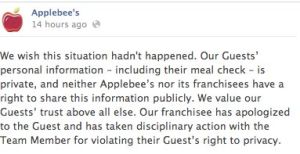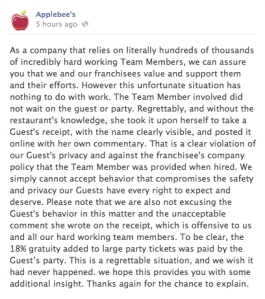 |
| via http://oldpeoplefacebook.tumblr.com/ |
But earlier this month some drama went down on the Applebee's FB page. Possibly more dramatic that the Alamo.
Journalist R.L. Stollar lays it out really well in a blog post he wrote as the restaurant chain slowly committed "Social Media Suicide" over the course of several hours. Basically, Applebee's fired an employee for breaking some sort of confidentiality policy by posting photo of a note a customer had written on a receipt on Facebook. The receipt said, "I give God 10%, why should you get 18%?" This really pissed the Internet off. Soon enough people took to Twitter and Facebook to berate Applebee's for their action.
Now, if I were a national corporation, I would delete the hateful comments and move on with my restauranteering. But no, for some reason Applebee's responded. In a post that could have mended broken bridges and appeased angered patrons, Applebee's made everything worse. They posted this status:
Unfortunately, not two weeks earlier, Applebee's THEMSELVES posted a photo of a note a customer left on a receipt. And if there is one thing that pisses off the Internet more than restaurants firing people, it is restaurants being hypocritical liars! Or so it seems.
The whole thing is re-hashed on Stollar's blog, and the next 48 hours proved extremely challenging for whoever is in charge of the Applebee's Facebook/Twitter, who is most likely fired by this point as well. Applebee's took to responding directly to patrons' posts and arguing with people all within a comment thread on Facebook. It is really painful to watch:
The debacle got me thinking about Walther's Social Information Processing Theory (SIPT). The four following thoughts correspond with the four caveats of the theory that we discussed in class on Monday:
- Social goals exist in EMB: It is clear that through maintaining a Facebook and Twitter presence, Applebee's is attempting to create an identity for itself. By creating and ideally maintaining relationships with customers and patrons on Facebook, Applebee's is attempting to market themselves to a wider audience and increase interaction between customer and corporation. Even though people on Facebook can never know who "Applebee's" really is, or the team of people that handle social media for the establishment, they are able to converse with the restaurant, thus accomplishing the social goal of the restaurant.
- There's nothing special about non-verbal: Luckily for Applebee's restaurants can't really use social cues, but their marketing team can. In the screenshot above, the Applebee's Facebook posted, "If you knew me or we were face to face you'd know how much I care." The phrase, "If you knew me" is slightly hostile. Offended Internet users have been using this phrase forever to create a confrontational situation. By pointing out the virtual wall between Applebee's and the customer who is commenting, Applebee's initiates an argument. The passive aggressive nature of the comment ("No one's asking me to comment at 5 am") alone acts as a social cue to the reader (thus why seeing that screenshot seems painful--or at least in me elicited a "oh no" reaction).
- Lean media takes longer to accomplish things: As evidenced by the hour-long battle between Applebee's and the greater Internet, lean media clearly takes longer to convey a message. Over the course of a 200+ comment thread, Applebee's relates the same message to different costumers over and over before finally breaking down and attempting to apologize to users individually. The idea that lean media has to figure out how things are conveyed is obvious in this example. How can Applebee's tell the Internet how truly sad and sorry they are about making everyone so angry while still maintaining that they were justified in their decision to fire the waitress?
- With time, EMC can be as effective as face-to-face: I think that is possible that Applebee's could have effectively conveyed a message about the situation before it devolved via EMC. For example, it probably would have been well-advised if they had deleted the photo they uploaded of a customer's receipt. They should not have allowed someone with the Facebook password to continue leaving passive-aggressive comments until past 5 in the morning. And they probably should have just posted one single, umbrella apology or statement about their action on their page itself as opposed to within a comment thread. And Applebee's did, after the initial chaos had blown over, delete the thread and post a blanket statement:
Unfortunate PR move for Applebee's? Yes. Hilarious? Absolutely. And certainly there is a lesson to be learned here about the power of social media and the precautions that should be taken when putting one's self out there.



No comments:
Post a Comment